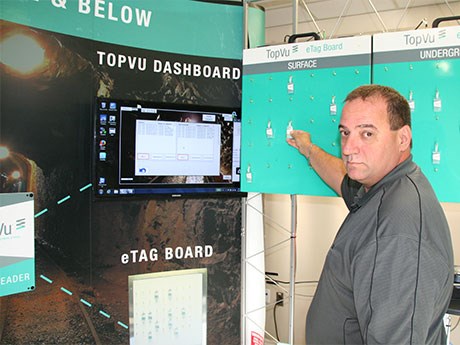TopVu eTag system is one of several RFID solutions available to boost efficiency in the mining industry
It looks the same as a tag-in, tag-out board in most mines, but the TopVu eTag board incorporates electronics that pick up the location of RFID tags on the board and import the information into a database.
Down the hall in the mine’s control room, a computer dashboard reveals who has tagged in and where they’re working.
The eTag board is one of K4 Integration’s TopVu line of RFID solutions. The Sudbury-based company began working on the board two years ago, and demonstrated it at the IMEX show in Las Vegas last year.
The main reason for developing the eTag board was to free clerical staff from poring over hard copy time sheets to calculate bonus pay for miners working on certain levels.
“Now, it’s all electronic,” said TopVu sales manager Marc Brunet. “As soon as my tag is read on the 5000 Level (section of the board), for example, they’ll know to pay me bonus.”
Another benefit of the eTag board is that surface personnel don’t have to physically go to the board to see where everyone is in the event of an emergency.
The board is currently installed at the NORCAT experimental mine in Onaping, north of Sudbury.
K4 also supplies underground RFID tracking systems to provide real time location data.
Geared for small to medium-sized mines, the TopVu underground tracking systems use passive RFID technology, which is more economical and doesn’t require a full-blown WiFi system, said Brunet.
“We went the passive route because there are a lot of companies out there using active RFID tags that need battery power to work. We use passive RFID tags, a technology that’s widely used in the retail industry. They’re pennies apiece and we stick them on hard hats – not cap lamps. Cap lamps can be shared. If a lamp is broken, I’ll grab another one. Nobody shares hard hats.”
The passive RFID tags have a range of seven to 10 metres.
“If you’re in a rush and forget to tag in, the readers underground will pick you up and an alert will go out to your boss,” said Brunet. “The readers will track miners as they move from level to level. In an emergency, for example, the system knows you were last seen on the 7000 Level even though you tagged in to work elsewhere.”
K4 Integration came up with an especially innovative application of RFID technology to help Agnico Eagle’s La Ronde Mine in northwestern Quebec keep track of its gas detectors.
“Before, they were just spread out on a table,” said Brunet. “Guys were losing them, or leaving them in the dry. They’re $250 a piece, so it was a big expense. They told us ‘We can go into the dry right now, drop all the baskets and there could be 30 to 40 gas detectors up there.’”
K4 Integration solved the problem by building a gas detector dispenser. A miner preparing to tag in is alerted to a potential gas risk on the level he’s assigned to. He takes his tag to the dispenser and if he’s trained to use the detector, the door opens and he takes the one he needs. The detector also has an RFID tag, so the system associates the miner with the detector. At the end of the shift, the miner returns the detector to the dispenser and the two are dissociated. If it’s not returned in 24 hours, an alert goes out.
Ideas for new TopVu products usually come from visiting mines and learning about their opportunities to boost productivity and streamline administration.
In one mine Brunet visited, contractors signed in and out on a dozen or so clipboards – one for each contractor. At month’s end, clerical staff would go through the sheets and manually add up the hours worked to make sure they corresponded with the contractors’ invoices. Instead of the clipboards, K4 Integration proposed the use of a touch screen kiosk that would record the number of hours worked by individual and automatically produce a report at the end of the month.
At Glencore’s Fraser Mine in Sudbury, K4 Integration installed an RFID reader on a sprayer and a tag on the wall of a drift near an electrical substation.
“As the sprayer drives by and picks up the tag, it stops spraying,” said Brunet.
At First Nickel’s Lockerby Mine, which was shut down in August due to low commodity prices, K4 Integration installed tags and readers to keep track of haul trucks travelling up ramp from 6000 Level to a load-out area at 5200 Level. The data helps mine management monitor cycle time because “if you can increase the speed of a truck two or three kilometres an hour and make an extra trip per week, that’s big money for the mine,” said Brunet.
Using load cells on buckets, K4 Integration can also collect data on tonnes moved per truck. Once again, the benefit lies in maximizing the movement of ore.
For some of these applications, K4 Integration uses battery-powered active RFID tags with greater range.
K4 Integration was founded in 2008 with a focus on truck scales. Over the following years it expanded into automation, instrumentation and gas monitoring. TopVu, the company’s RFID division, was launched in 2013.
The company is currently focused on serving the mining industry in Northern Ontario and northwestern Quebec, but wants to expand its reach to western Canada and eventually to South America and Australia, said Brunet.



